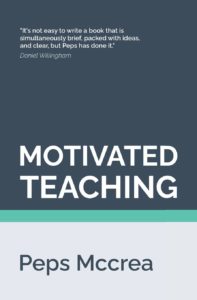In many cases, cognitive science offers clear teaching advice.
You’re curious about working memory? We’ve got LOTS of strategies.
Wondering about the limits of attention? Good news!
Alas, in other cases, research doesn’t give us such clarity. If, for instance, I want to ramp up my students’ motivation, what should I do?
Should I put up posters with uplifting quotations?
Should I encourage grit?
Or, should I promote a “growth mindset”?
If you’d like answers to these specific questions — and the broader questions that prompt them — I have a place to start: meet Peps Mccrea.
In his new book Motivated Teaching, Mccrea sorts though dozens/hundreds of studies to create a clear, readable, research-informed, and practical guide to the science of student motivation.
Here’s the story…
Evolution, and Beyond
Mccrea, sensibly enough, starts with an evolutionary perspective.
Humans face a cognitive problem: the environment offers us so many stimuli that we can struggle to know where to focus our attention. (Teachers REALLY care where students focus their attention.)
Motivation helps solve this problem. If I’m motivated to do Y, I will attend to Y; if I attend to Y, I just might learn it. As Mccrea pithily writes, “Motivation is a system for allocating attention.” *
How then do teachers amp up motivation?
For an initial answer to this question, Mccrea turns to behavioral economics. In his formulation, students feel motivated to learn when
… they see the VALUE in what they’re learning,
… the ODDS ARE GOOD that they can learn it, and
… the COSTS of learning are low.
If we manipulate these variables just right — increasing the odds of learning, reducing the costs — those teacherly efforts create student motivation.
For instance, I’ve spent years emphasizing the importance of classroom routines. From my perspective, they reduce working memory load — usually a good thing.
From Mccrea’s perspective — thinking about that cost/benefit formula above — routines reduce the costs of learning. Once students have classroom systems and mental systems in place, they can easily use them to learn more complex material.
As Mccrea says: we should make “the process of learning easy, whilst keeping the content of learning challenging.” (You see what I mean about his catchy summaries?)
Learning Is Individual AND Social
Of course, learning takes place in a social context, and Mccrea studies that research pool as well.
For instance, he highlights the importance of school and classroom norms. If students see that, around here, we all act a particular way, they’re likelier to join in the normal behavior they see.
For this reason, Mccrea advocates taking the time we need to articulate and re-establish our norms. Early work now will pay off later in the year.
By the way, Mccrea’s chapter here reminded me of a powerful story. At the high school where I work, a new freshman once used a mild slur to insult a classmate. Before the teacher could do anything, one of the student leaders looked up and said five simple words: “We don’t do that here.”
Imagine the power of that sentence. If the new student wanted to be a part of “we” and “here,” he needed to change his behavior pronto.
Norm established.
The Big Pictures
In Mccrea’s system — to answer the questions that opened this post — motivation does not result from uplifting posters. It produces grit, but does not result from it. (Mccrea does not specifically mention growth mindset.)
In fact, he specifically discounts “fun” as a good way to motivate students. Fun is an extrinsic driver: one that we should use sparingly, and as infrequently as possible.
Instead, he argues that if teachers focus on five key drivers of motivation, their cumulative results will foster motivation; and thereby attention; and thereby learning.
When you start reading Mccrea’s book, be aware that he’s explicitly aiming for “ultra-concise.” He has, in fact, boiled an early draft of 200,000 words to this slim volume of 10,000 words. (You read those numbers right — two hundred thousand words boiled down to ten thousand. **)
To achieve that goal, he gives few detailed examples, and saves research for links that you can follow. To imagine Mccrea’s suggestions at work in your context, you really should take time with the exercises he outlines on his page 112.
In other words: because he condenses research so effectively — like a bouillon cube — we readers need to soak it in our own context to let it expand and work its flavorful magic. You won’t get a detailed motivation checklist; you’ll get something much better — a way to think about motivation in many classroom contexts.
As someone who has written a book about research on motivation, I can tell you: Motivated Teaching is an excellent, readable, and practical book. It’s so short, you can easily read it twice.
In fact, after you’ve finished your first reading, you’ll be highly motivated to do so.
* Mccrea is GREAT at this sort of succinct formulation. In this review, I’m working really hard to limit the number of quotations from the book. I suspect I could compose a review almost entirely of his wise sentences.
** At the same time I read Mccrea’s book, I listened to Ollie Lovell’s podcast interview with him. This astonishing fact comes from that interview. By the way, if you DO like podcasts and you DON’T yet follow Lovell, now is an excellent time to start. He’s a one-man Learning and the Brain podcast in Australia.





